
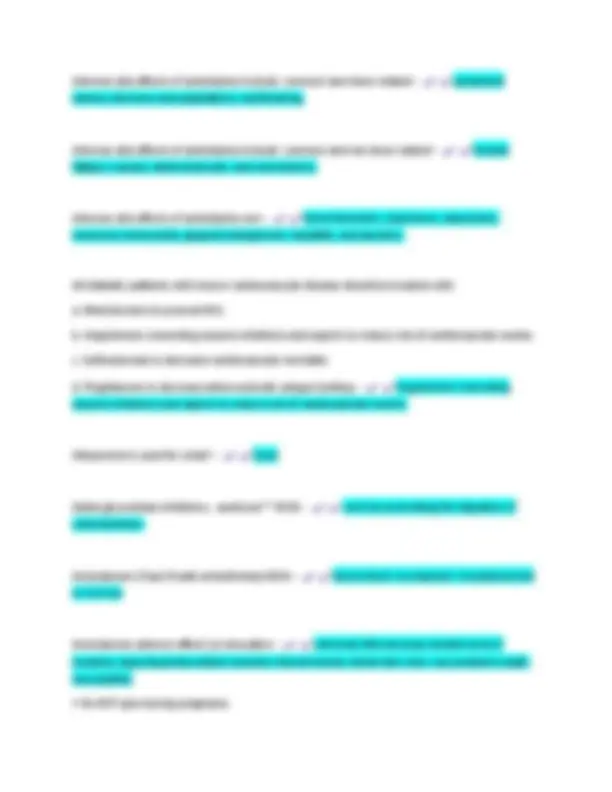
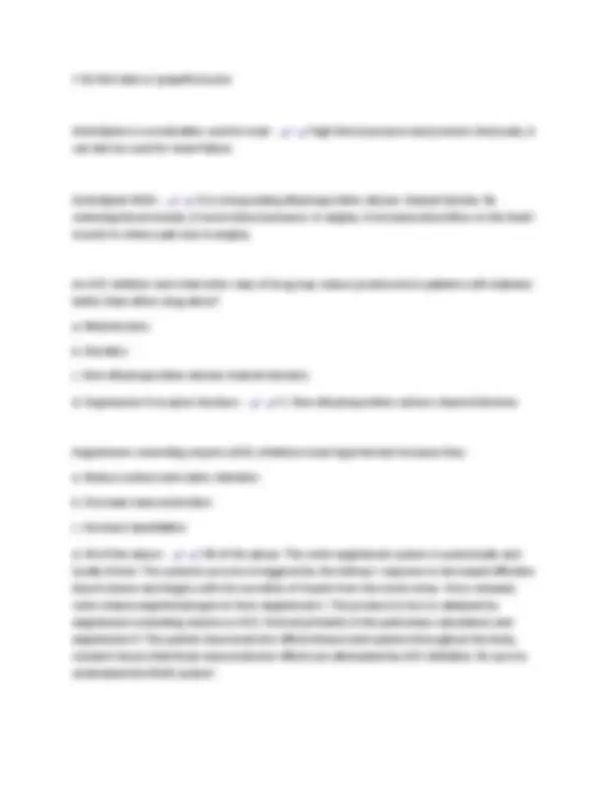
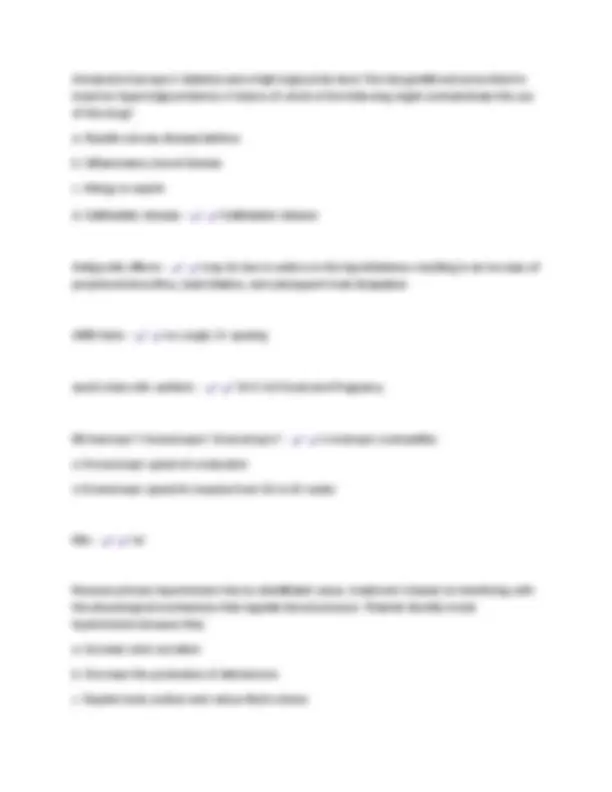
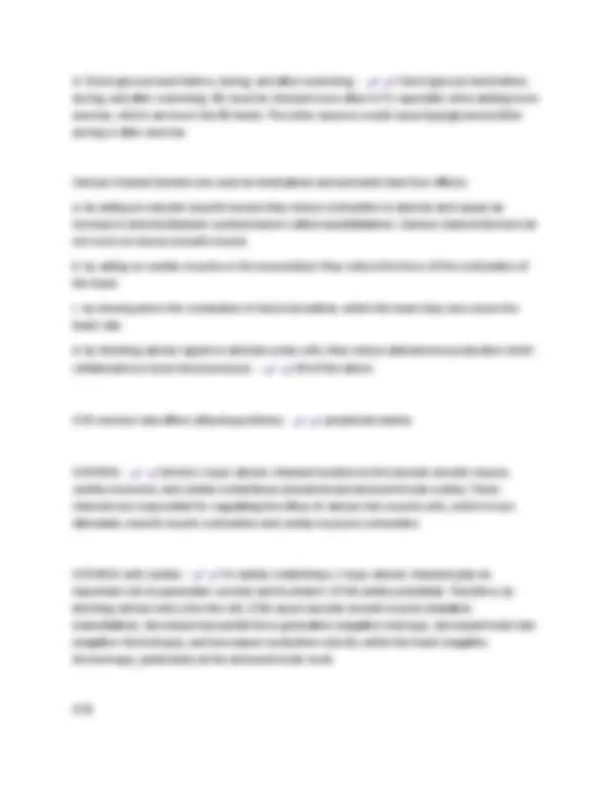
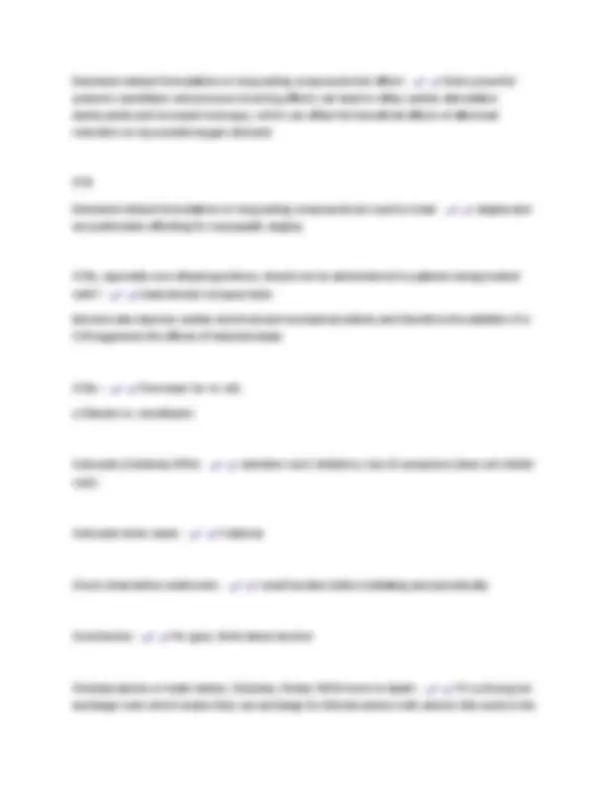
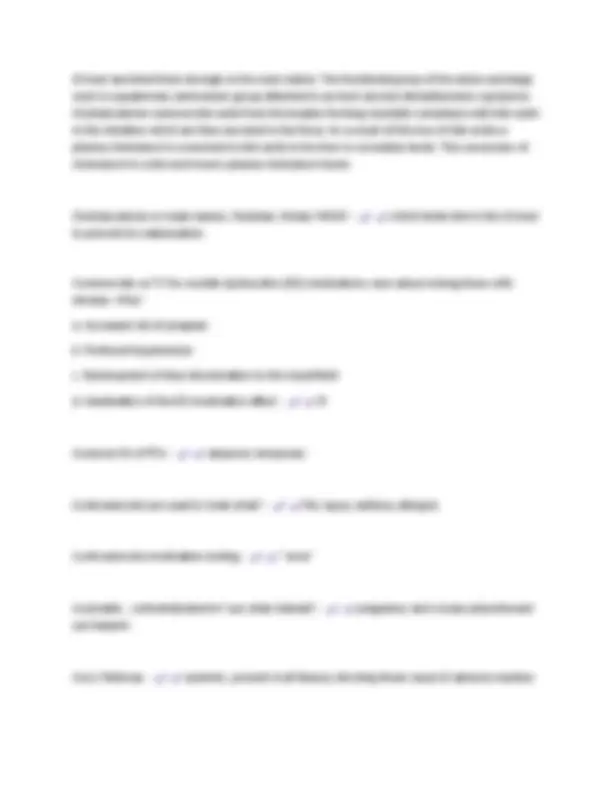
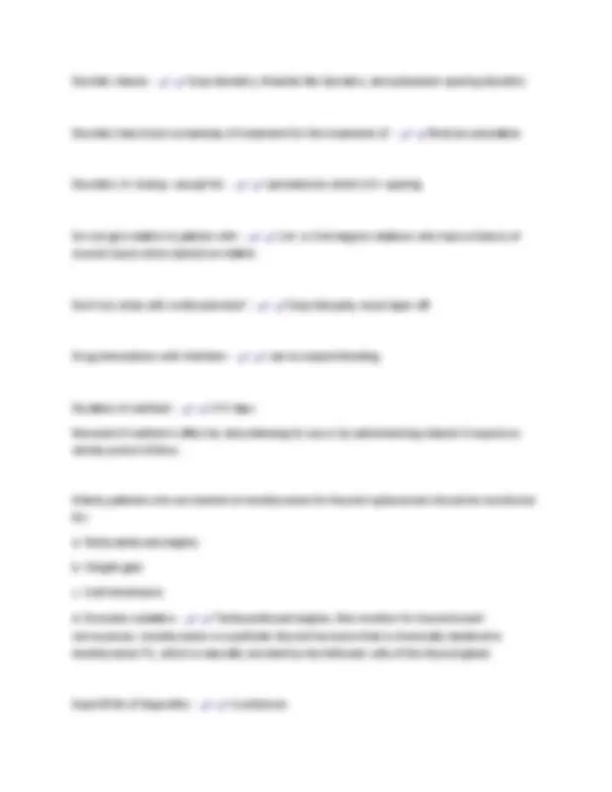
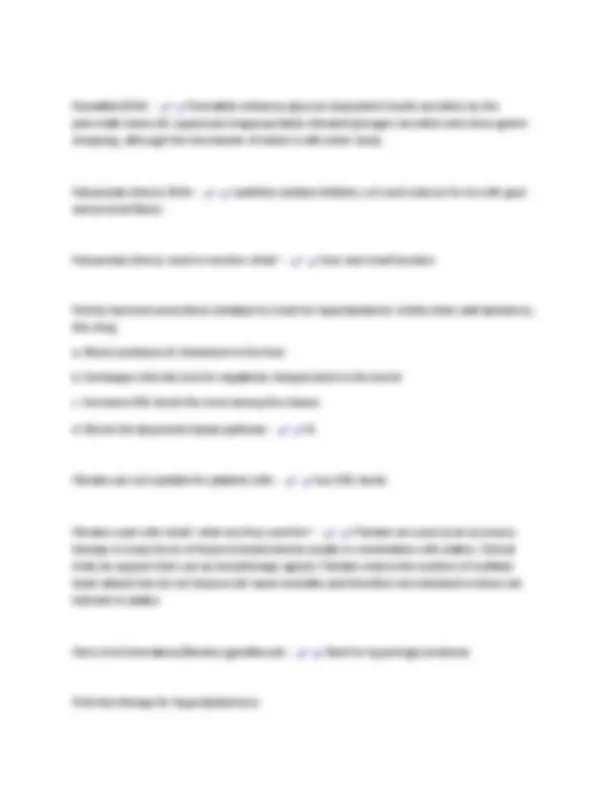
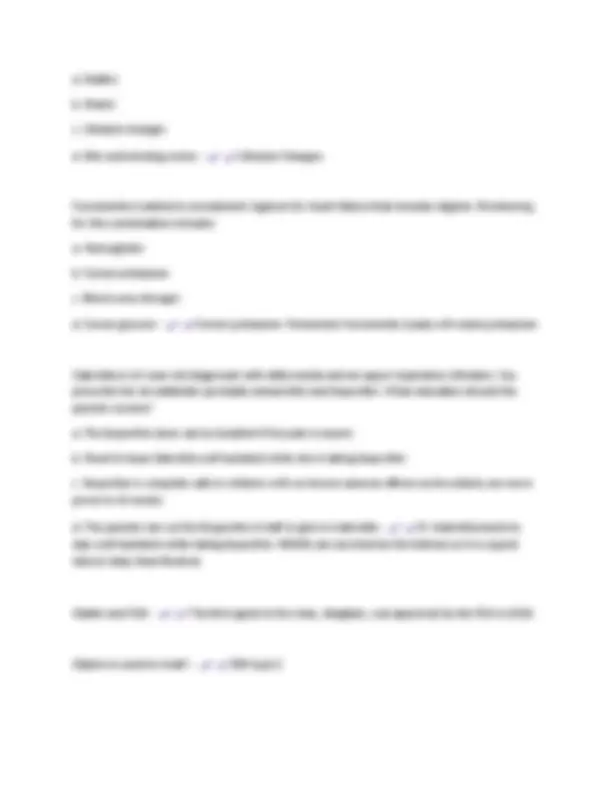
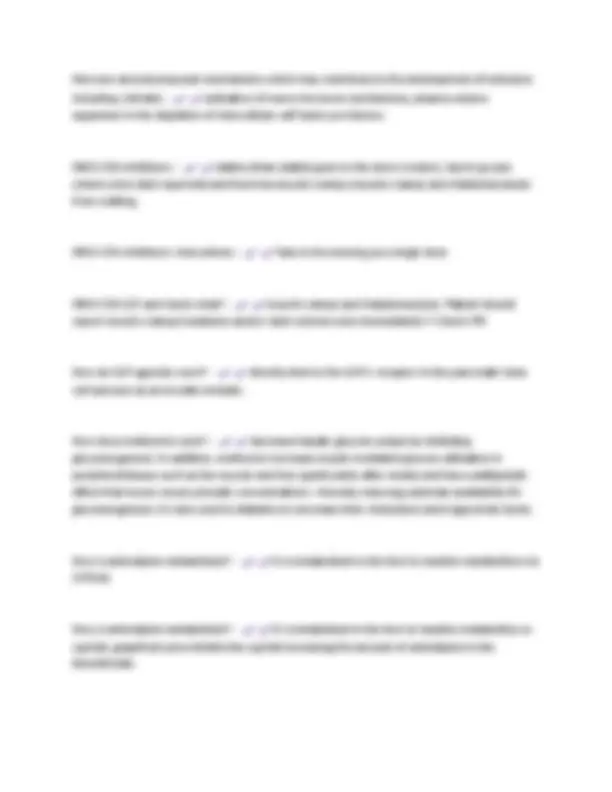
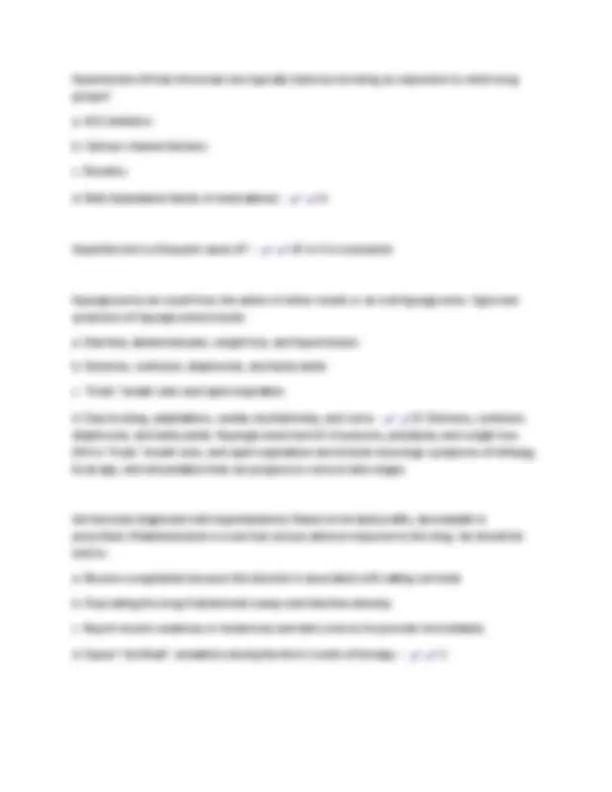
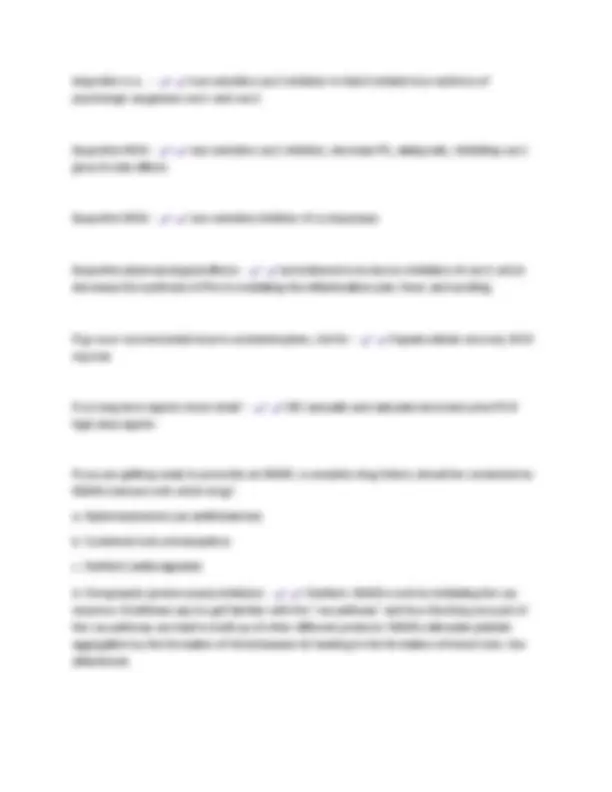
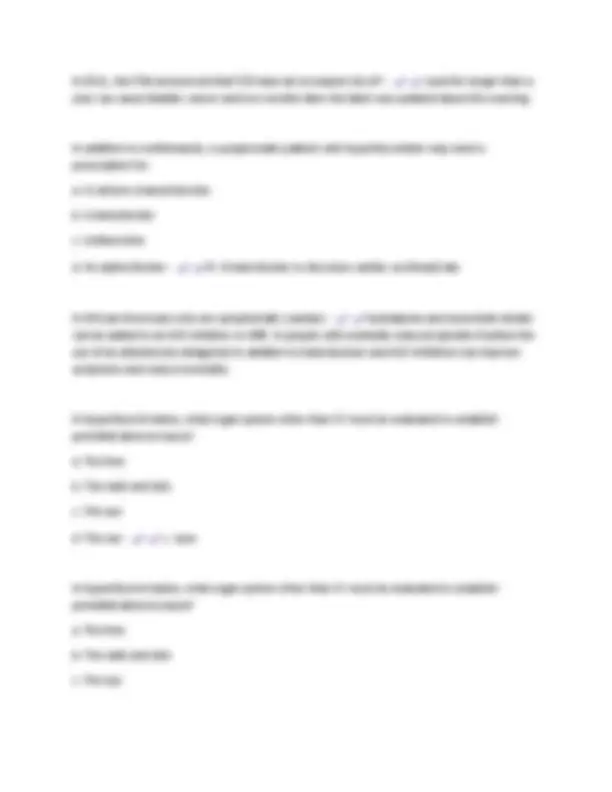
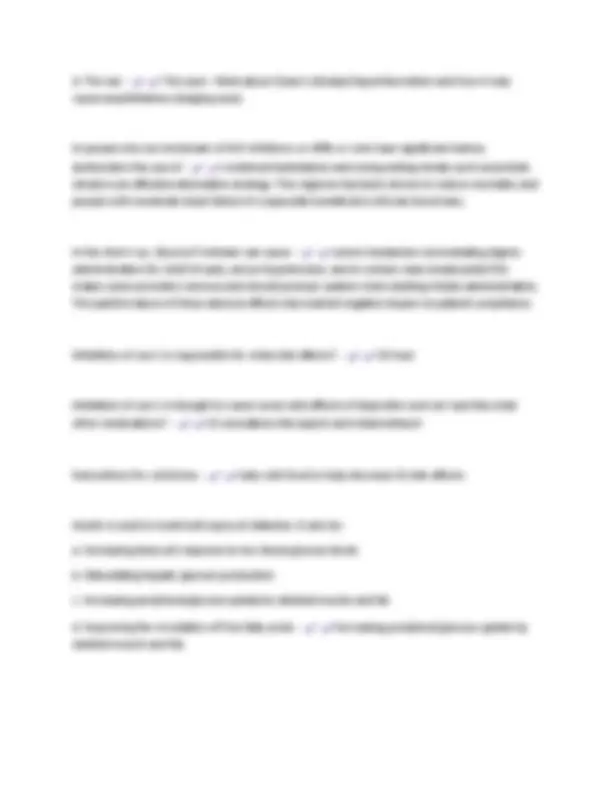
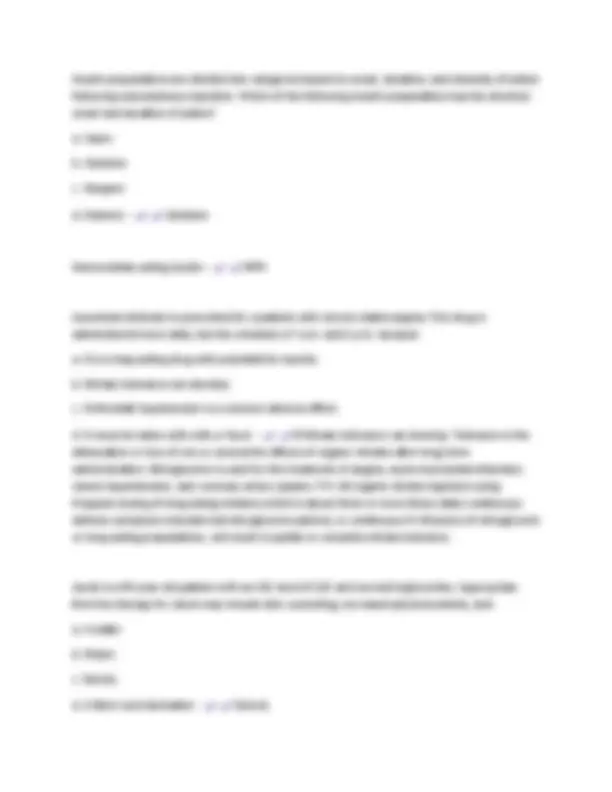
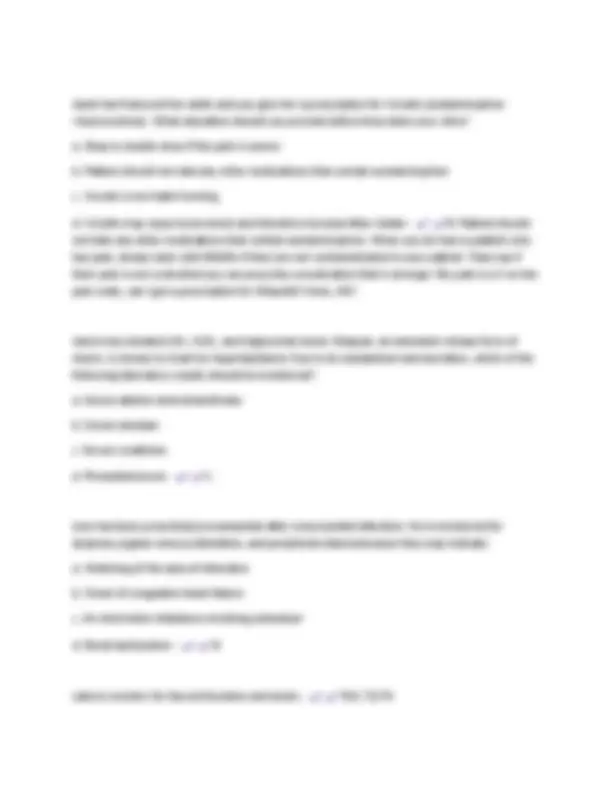
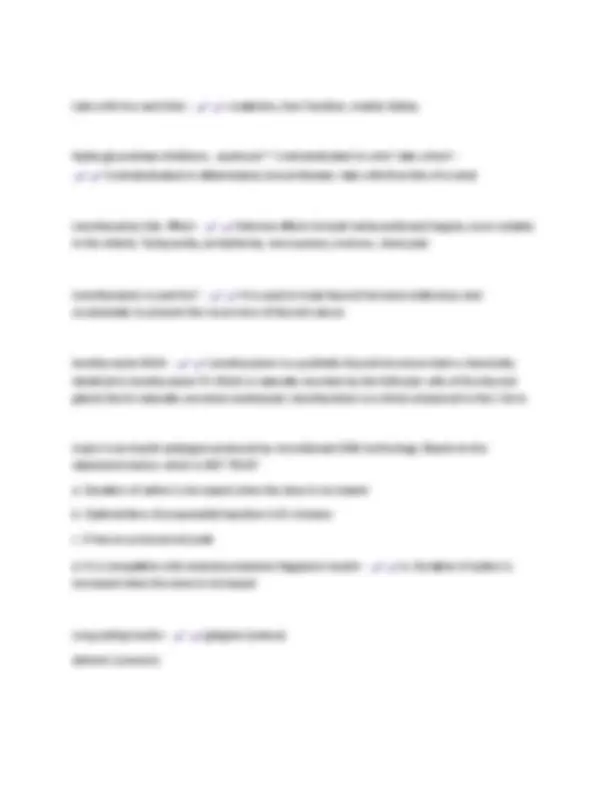
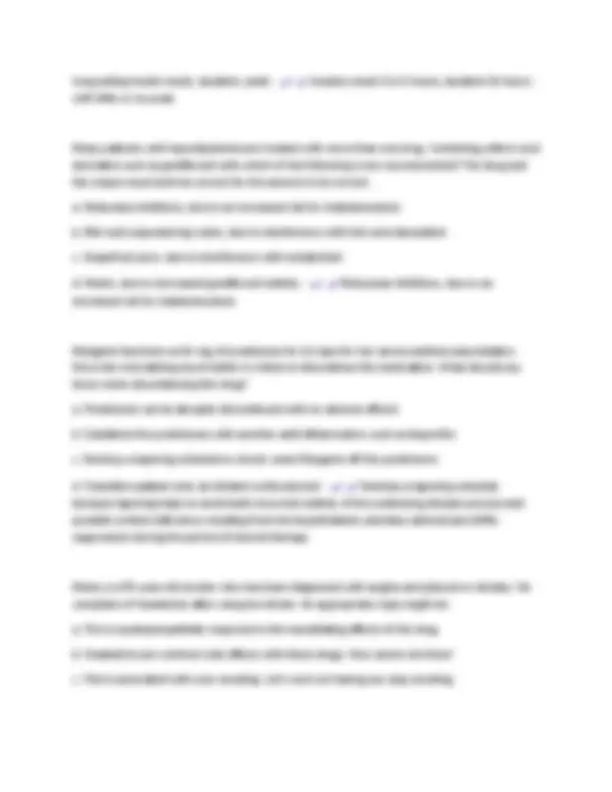
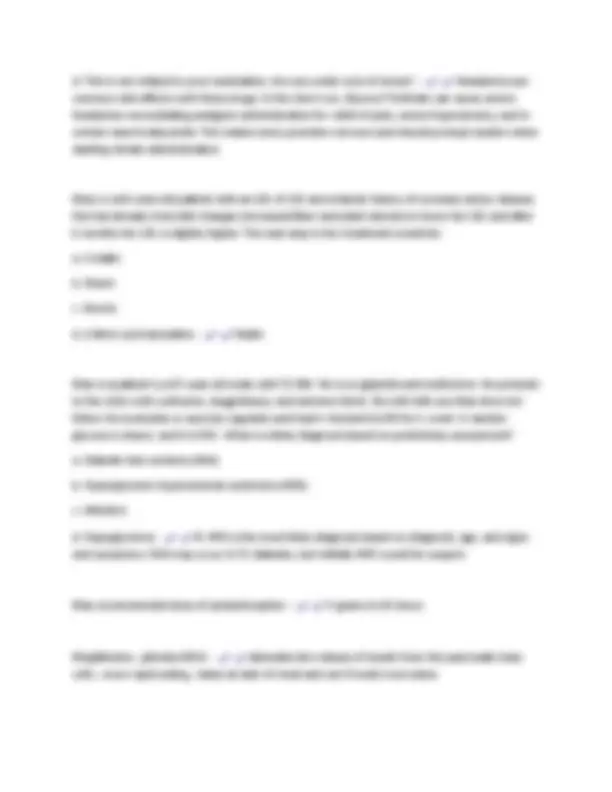
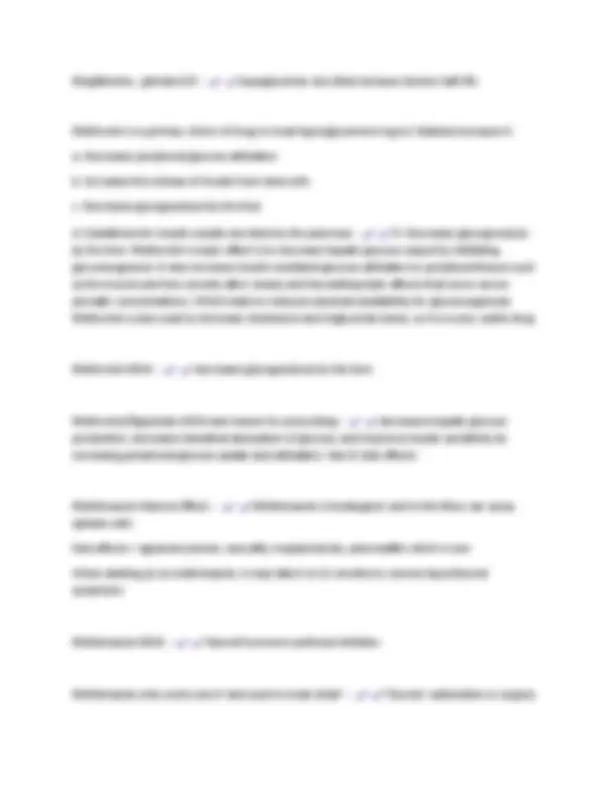
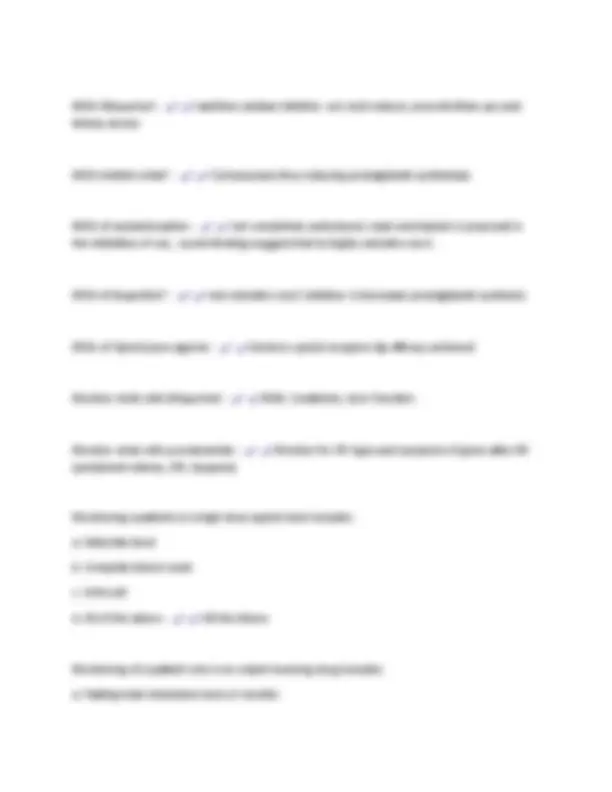
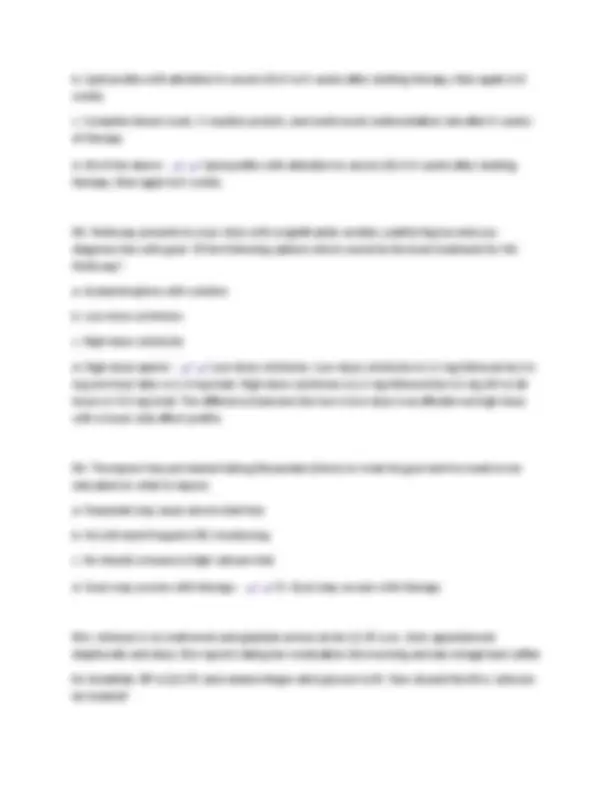
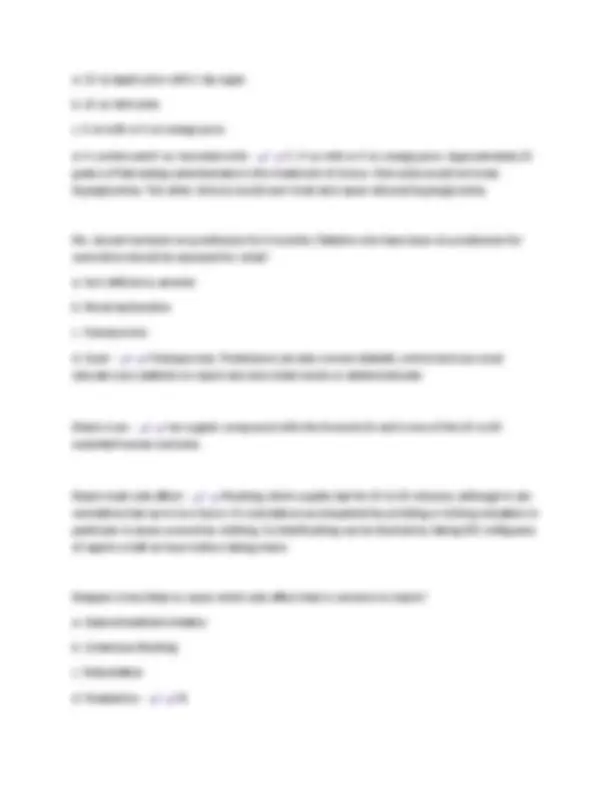
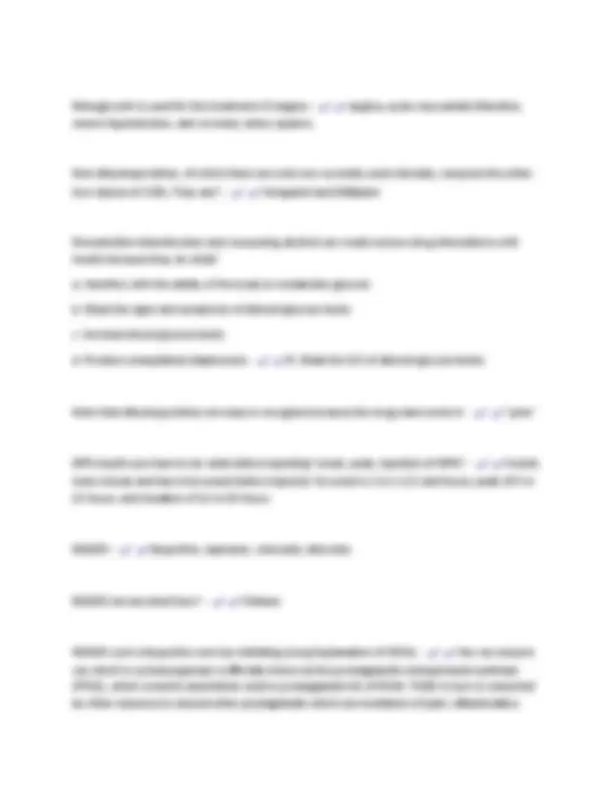
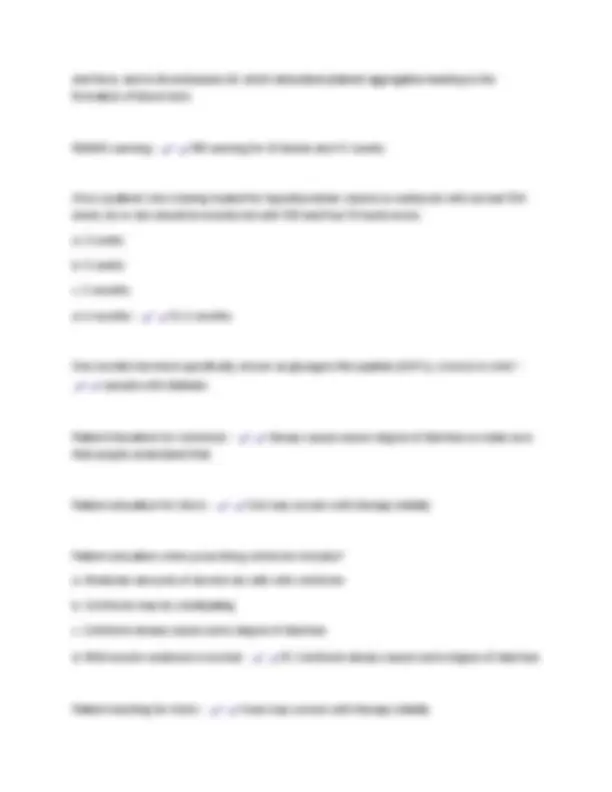
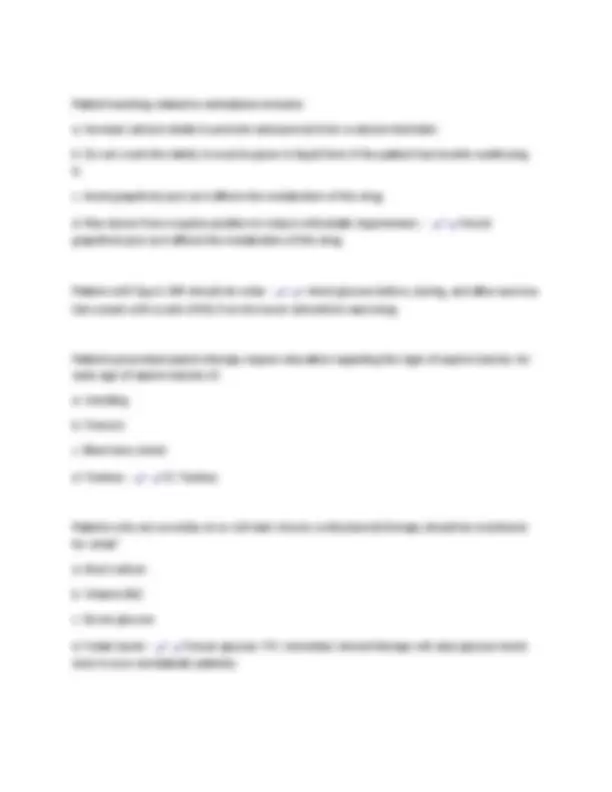
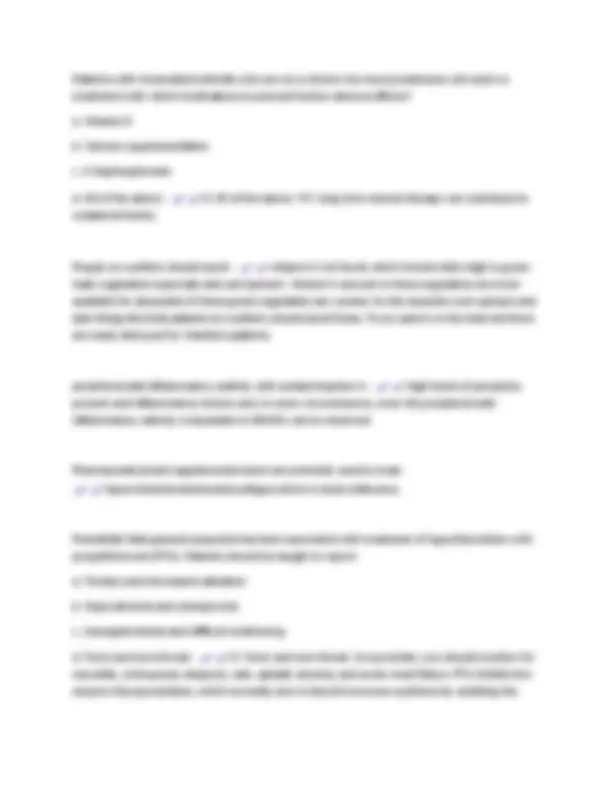
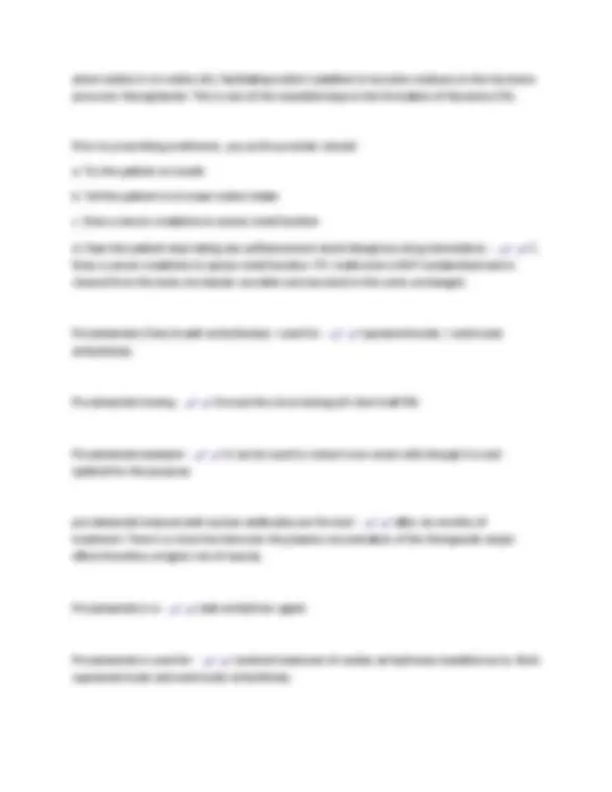
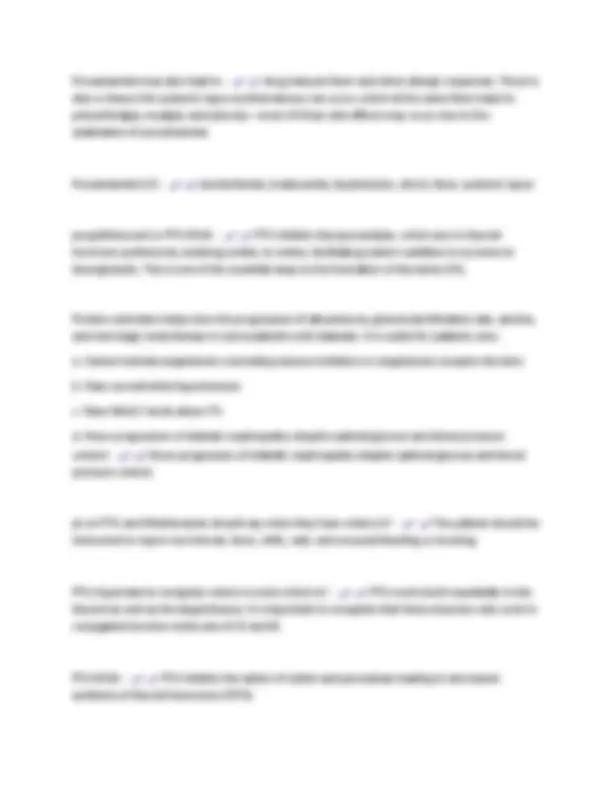
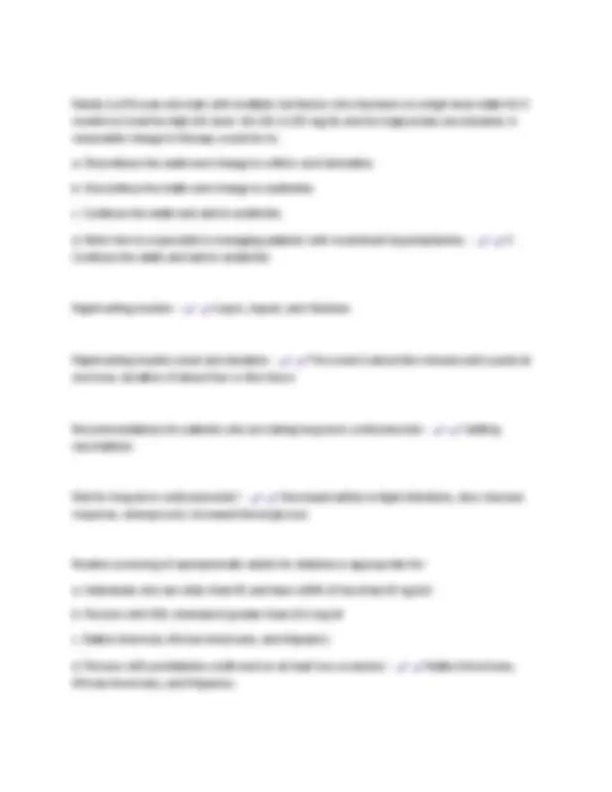
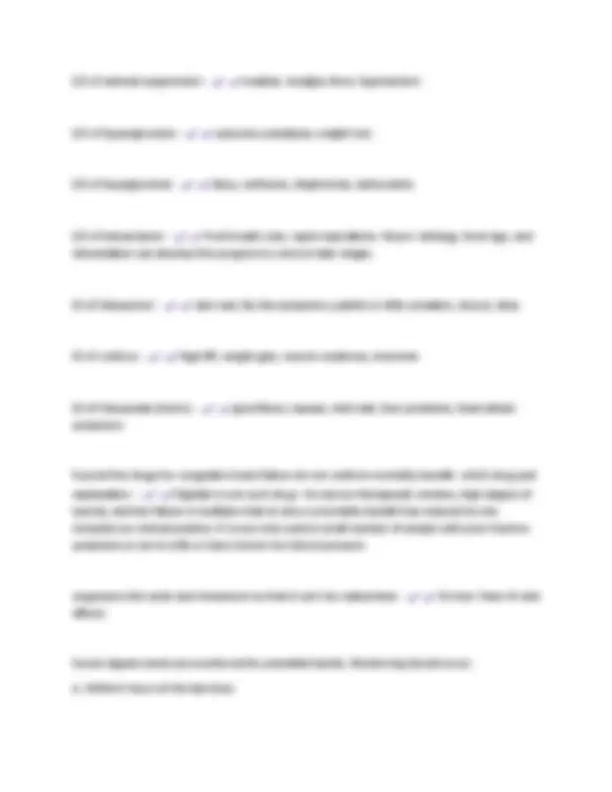
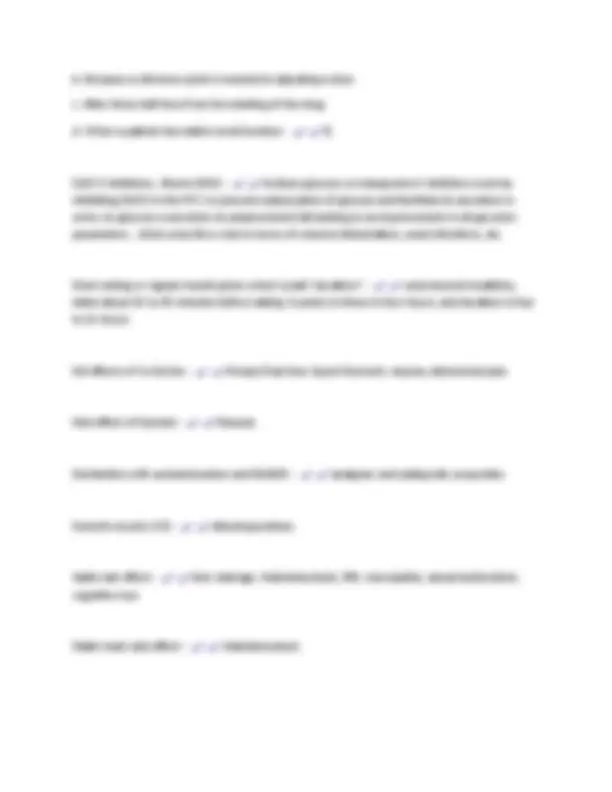
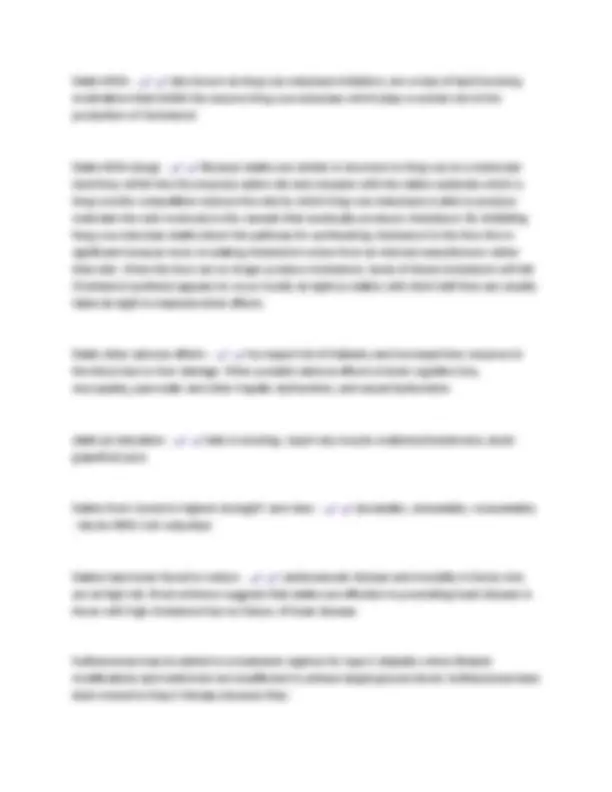
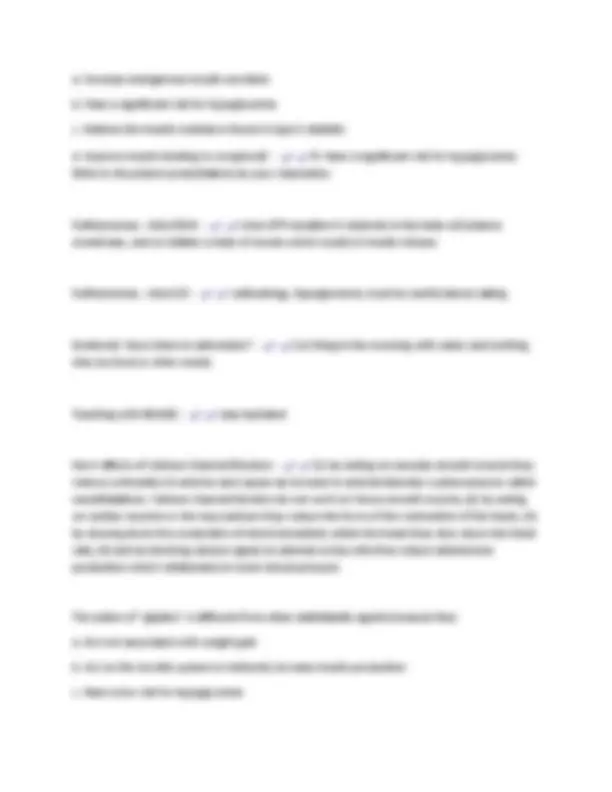
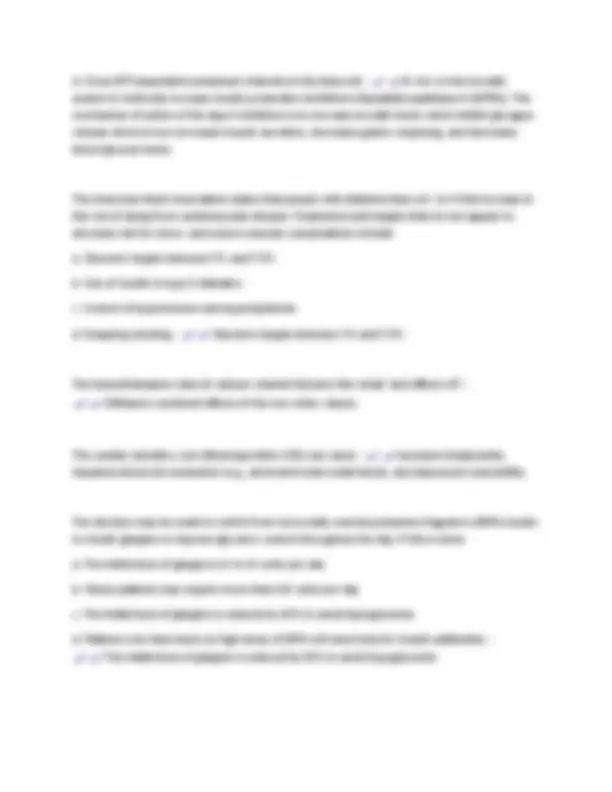
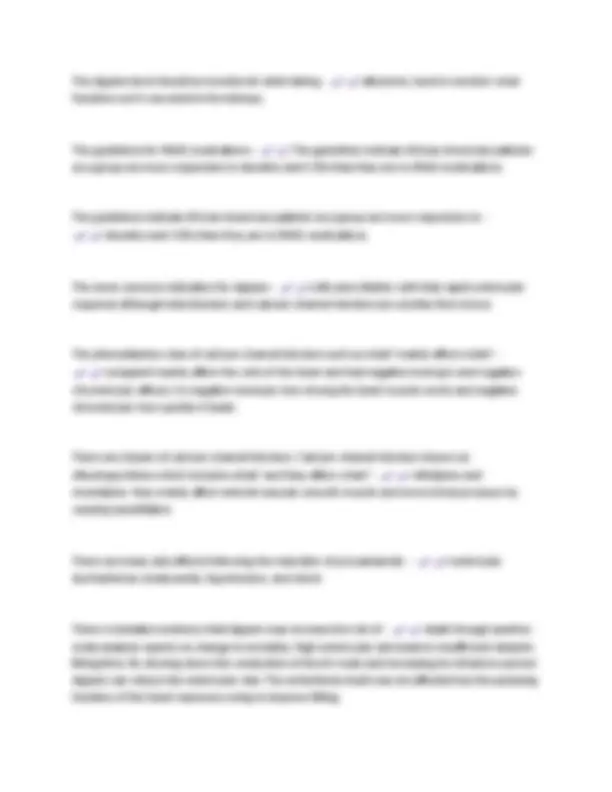
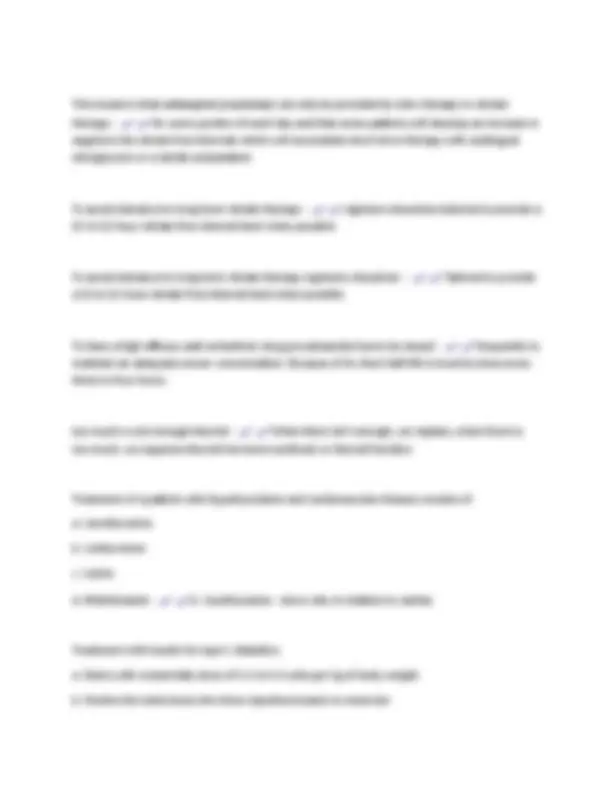
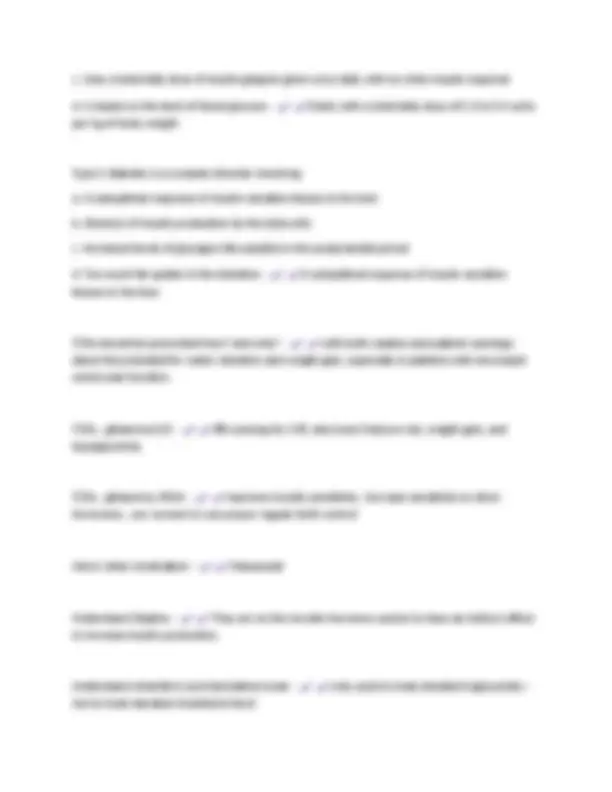
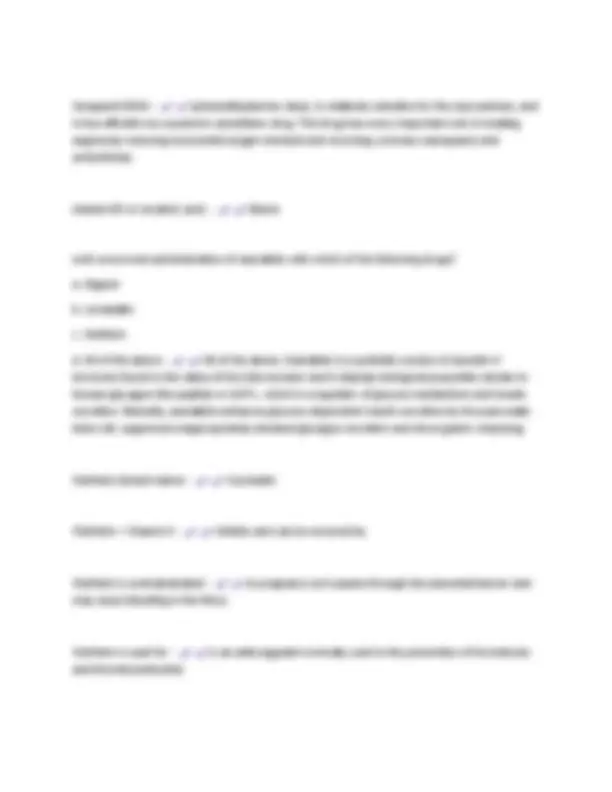
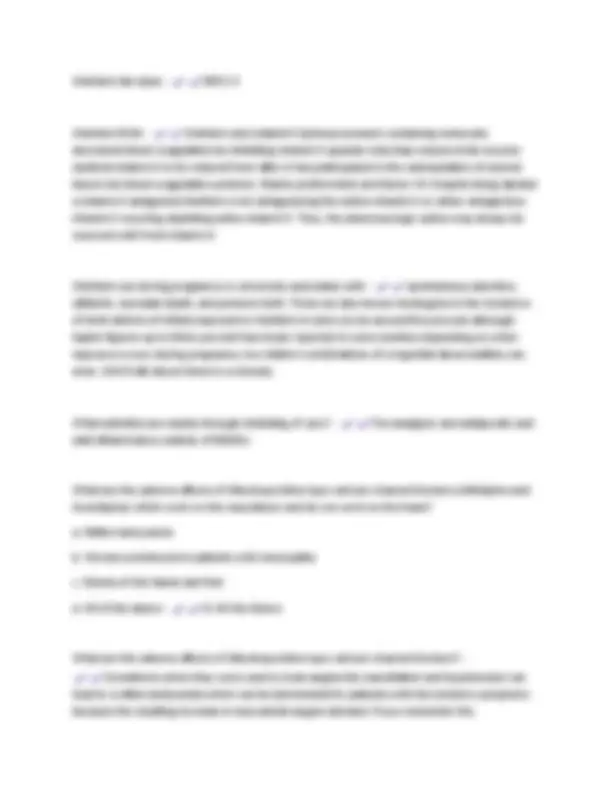
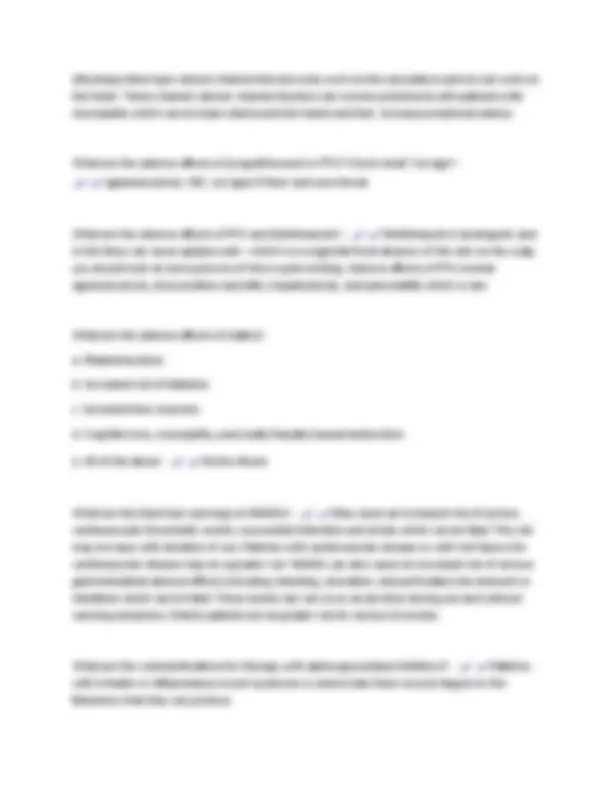
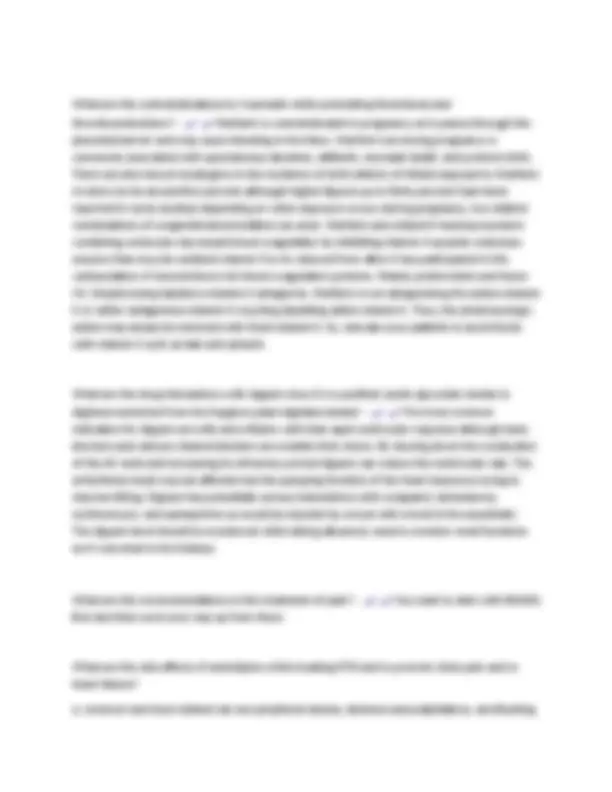
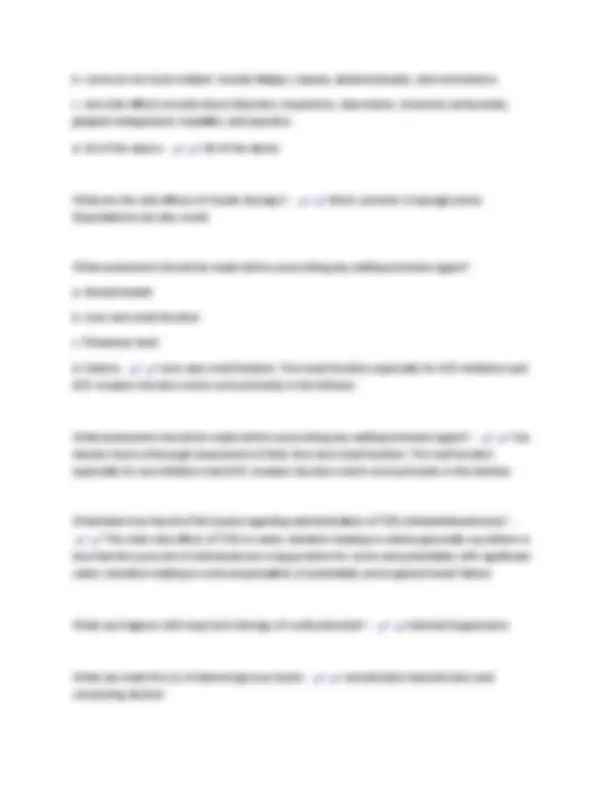
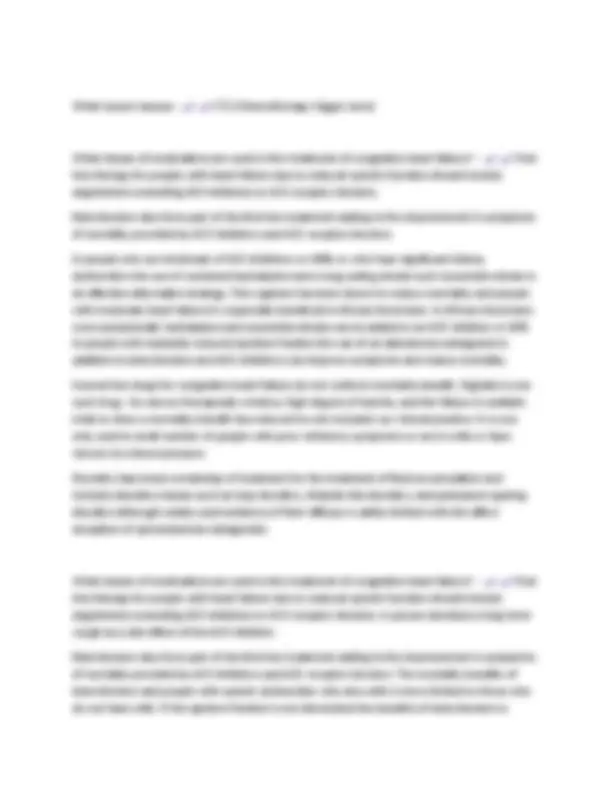
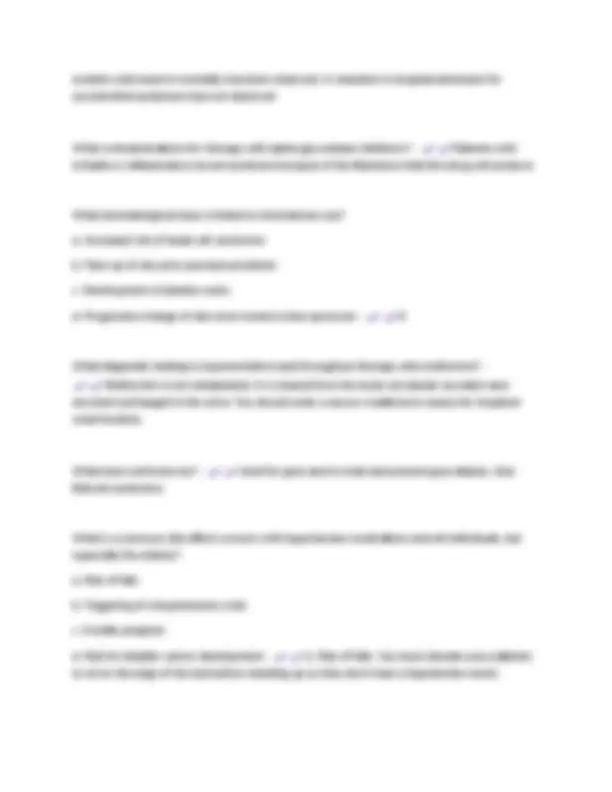
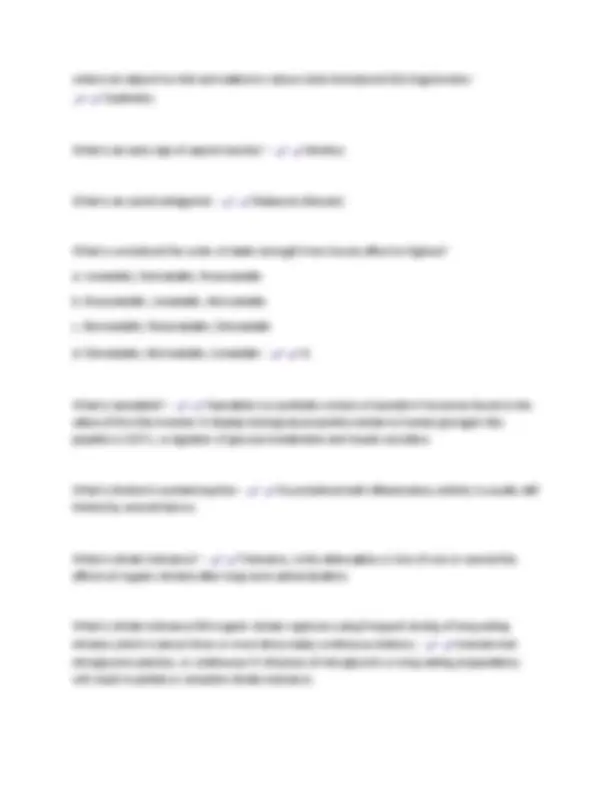
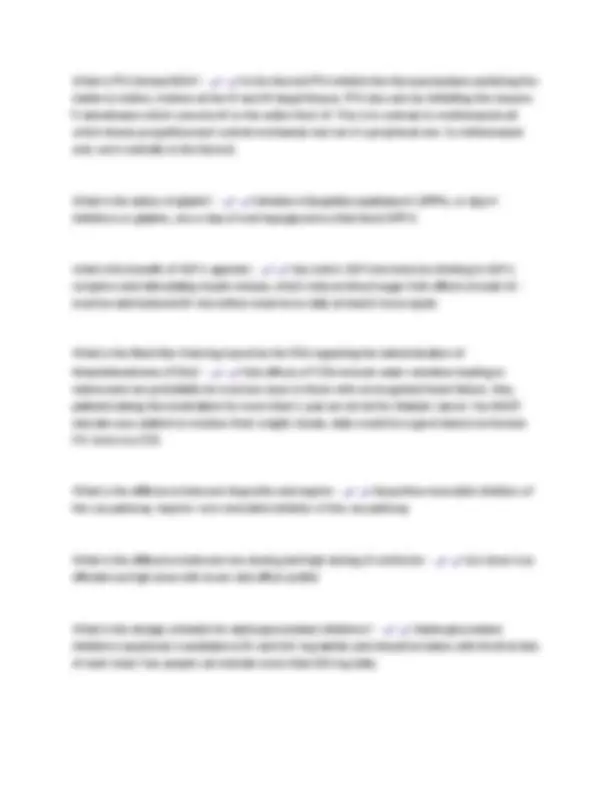
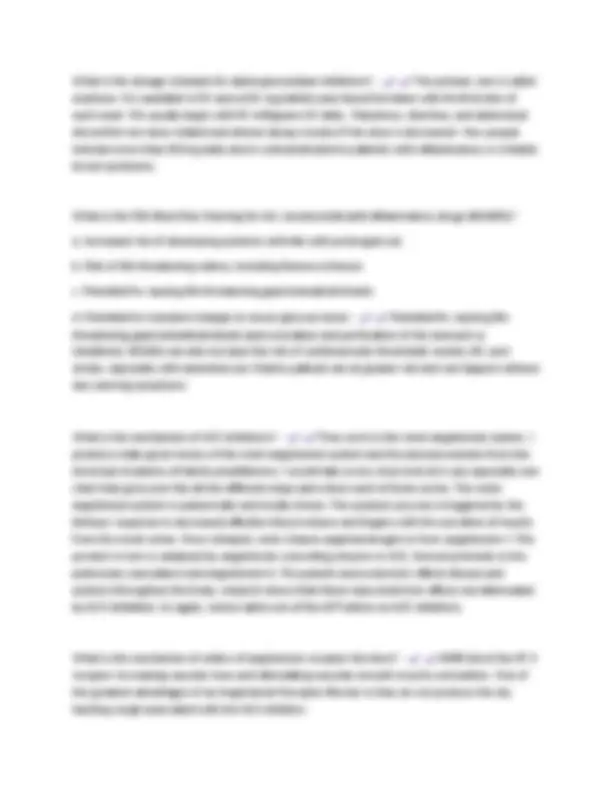
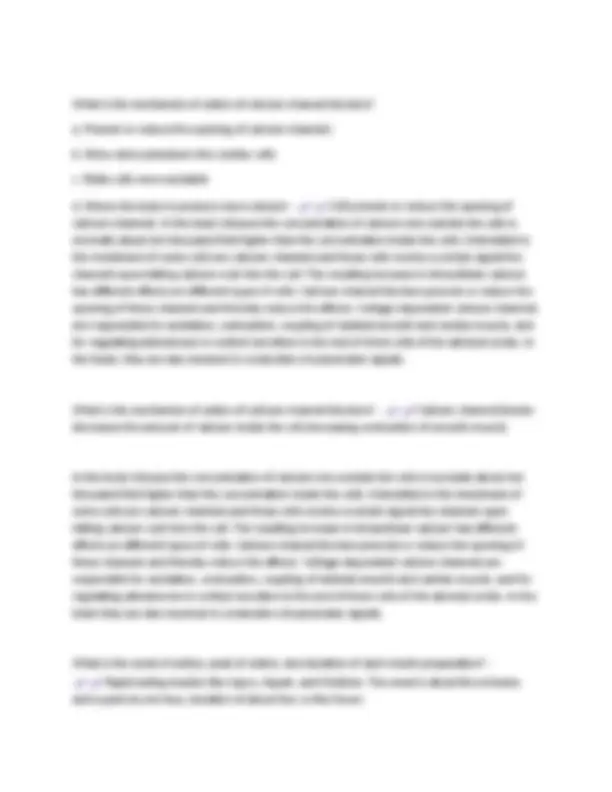
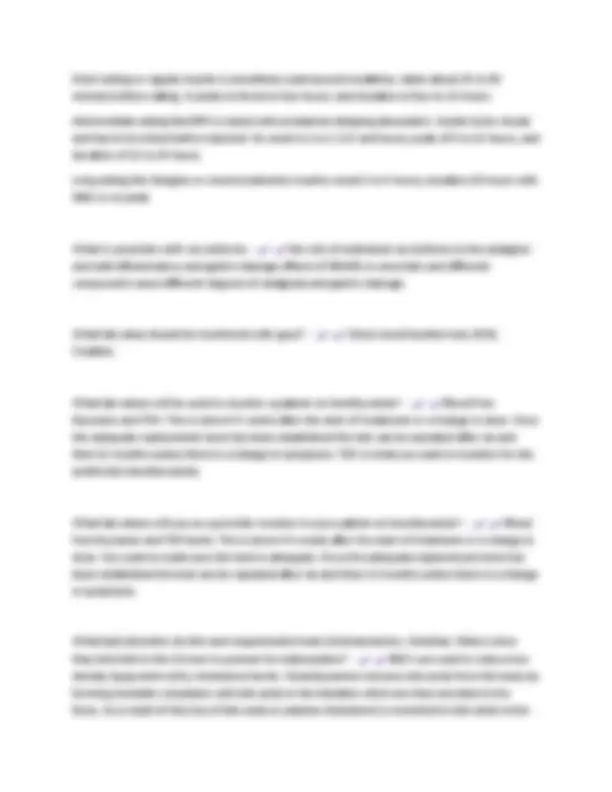
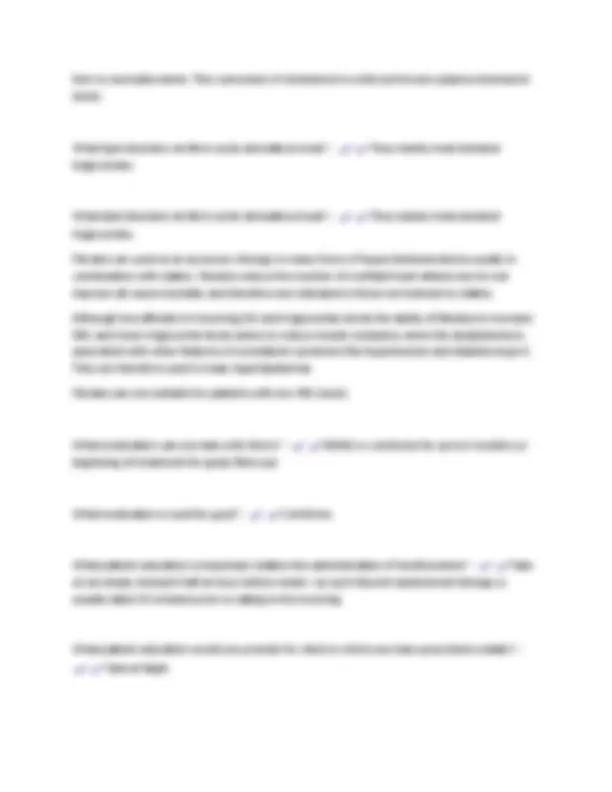
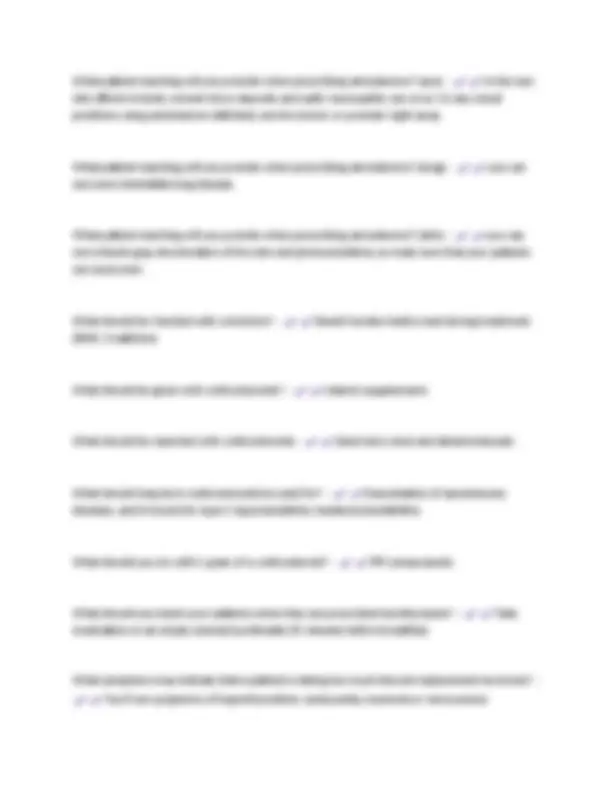
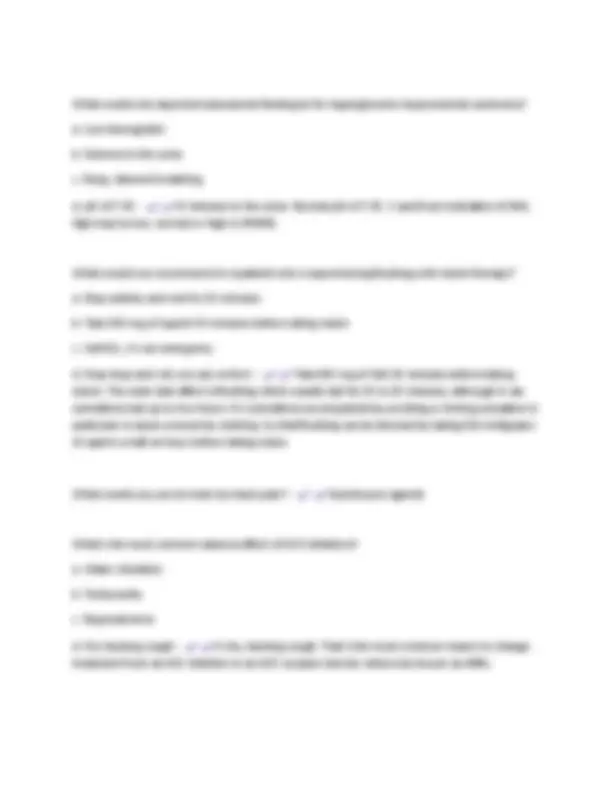
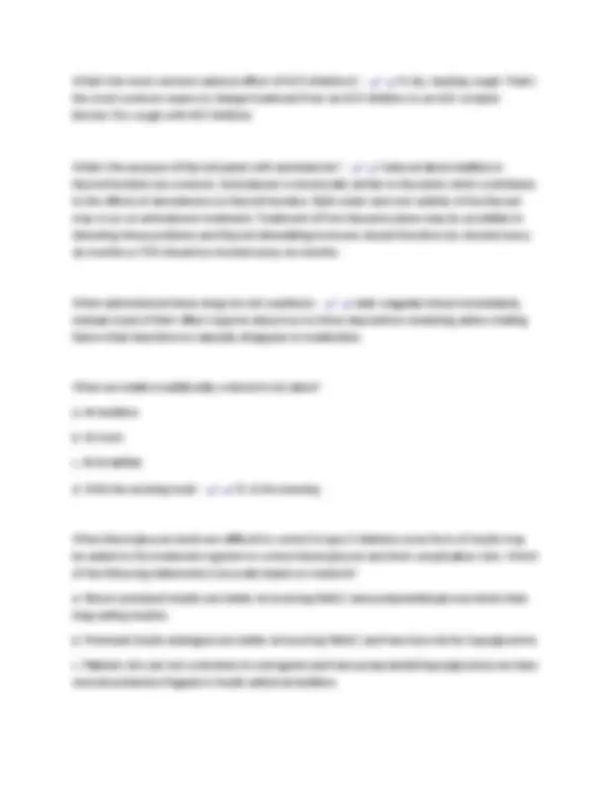
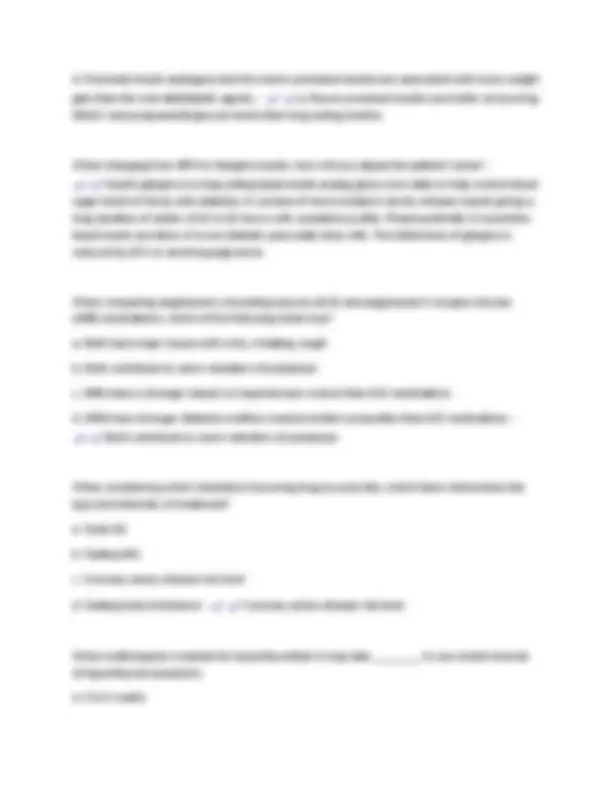
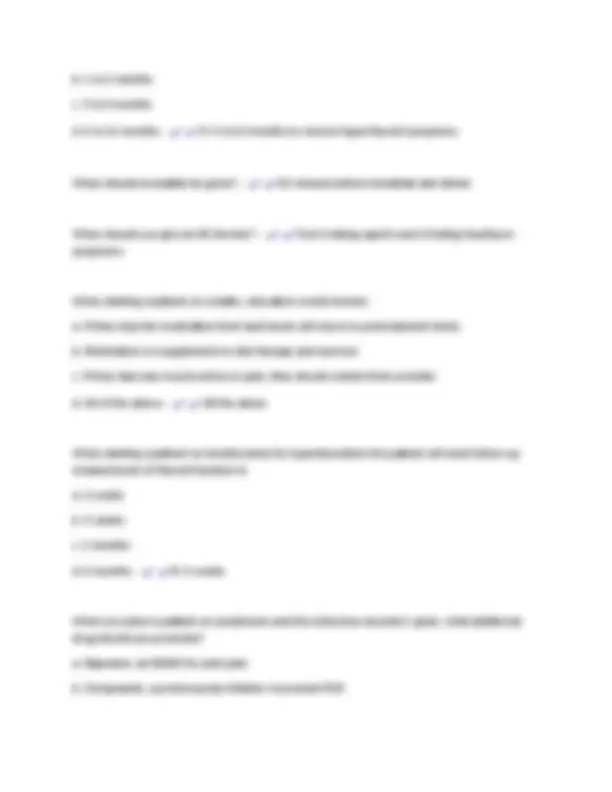
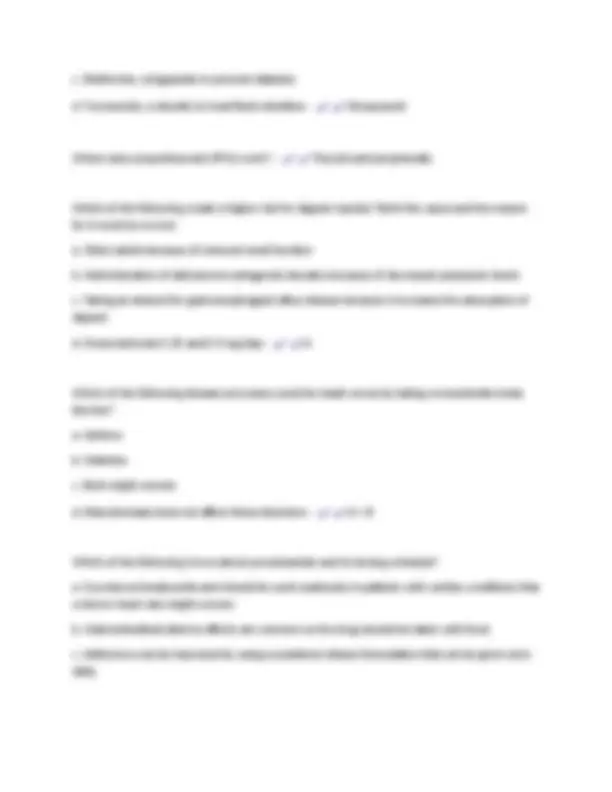
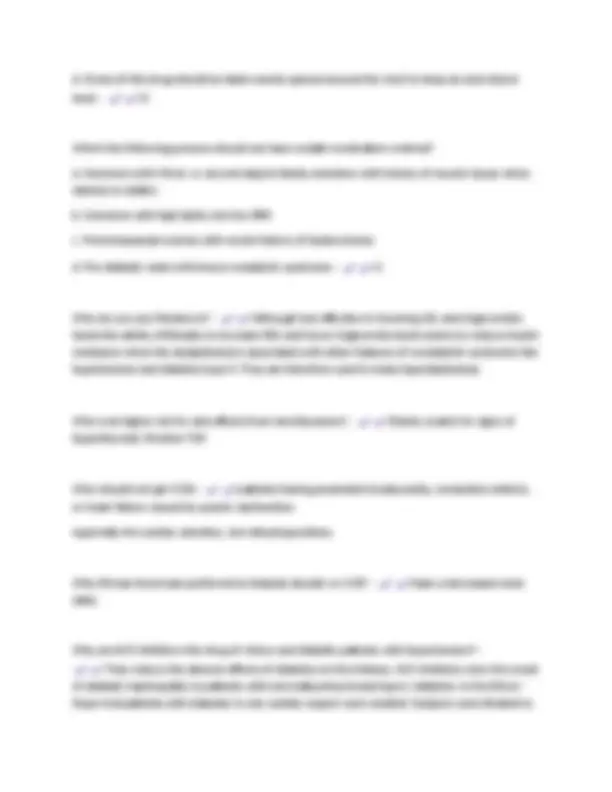
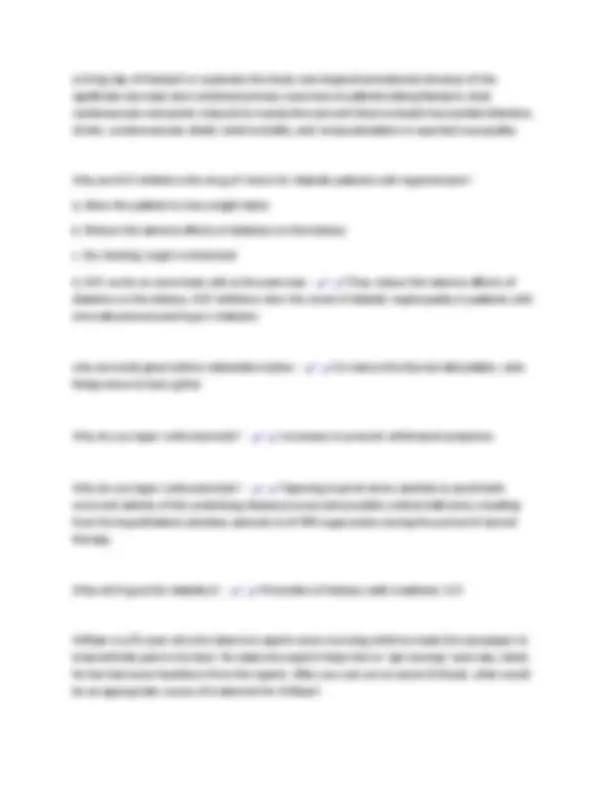
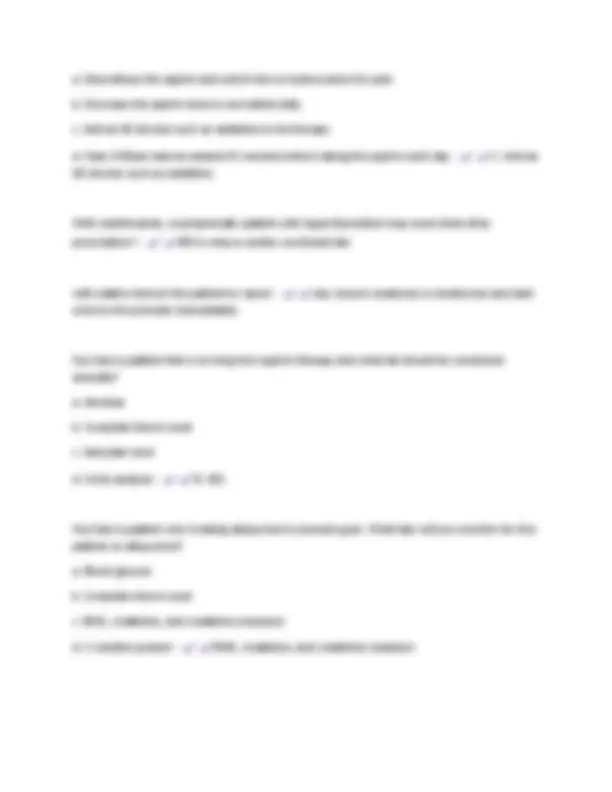


Study with the several resources on Docsity

Earn points by helping other students or get them with a premium plan


Prepare for your exams
Study with the several resources on Docsity

Earn points to download
Earn points by helping other students or get them with a premium plan
Community
Ask the community for help and clear up your study doubts
Discover the best universities in your country according to Docsity users
Free resources
Download our free guides on studying techniques, anxiety management strategies, and thesis advice from Docsity tutors
*Dosing for high dose colchicine - mg total. *Dosing for low dose colchicine - 1.2 mg followed by 0.6 mg every 4 to 6 hours; or 4.8 1.2 mg followed by 0.6 one hour later or 1.8 mg total 1st line for mild or moderate pain, inflammation - NSAIDS A patient develops toxic goiter. What's the recommended treatment? - Methimazole inhibits the enzyme thyroperoxidase, which normally acts in thyroid hormone synthesis by oxidizing the anion iodide (I−) to iodine (I2), hypoiodous acid (HOI), enzyme linked hypoiodate (EOI) facilitating iodine's addition to tyrosine residues on the hormone precursor thyroglobulin, a necessary step in the synthesis of triiodothyronine (T3) and thyroxine (T4). It is used to treat hyperthyroidism in patients with toxic adenoma or toxic goiter in preparation for more definitive therapy with radioiodine or surgery. So short answer, Methimazole. A recent Cochrane review found that in small studies use
Typology: Exams
1 / 68

This page cannot be seen from the preview
Don't miss anything!





























































*Dosing for high dose colchicine - 1.2 mg followed by 0.6 mg every 4 to 6 hours; or 4. mg total. *Dosing for low dose colchicine - 1.2 mg followed by 0.6 one hour later or 1.8 mg total 1st line for mild or moderate pain, inflammation - NSAIDS A patient develops toxic goiter. What's the recommended treatment? - Methimazole inhibits the enzyme thyroperoxidase, which normally acts in thyroid hormone synthesis by oxidizing the anion iodide (I−) to iodine (I2), hypoiodous acid (HOI), enzyme linked hypoiodate (EOI) facilitating iodine's addition to tyrosine residues on the hormone precursor thyroglobulin, a necessary step in the synthesis of triiodothyronine (T3) and thyroxine (T4). It is used to treat hyperthyroidism in patients with toxic adenoma or toxic goiter in preparation for more definitive therapy with radioiodine or surgery. So short answer, Methimazole. A recent Cochrane review found that in small studies use of diuretics appear to have - improved mortality in individuals with heart failure however the extent to which these results can be extrapolated to a general population is unclear due to the small number of participants in cited studies. A woman who is pregnant and has hyperthyroidism is best managed by a specialty team who will most likely treat her with: a. Methimazole b. Propylthiouracil (PTU)
c. Radioactive iodine d. Nothing, treatment is best delayed until after her pregnancy ends - B. Propylthiouracil (PTU) ACEs: Why cough as common side effect that causes need for med stoppage? - Due to the buildup of bradykinin in the lungs - Shadow health module has great visual of this Acteaminophen being cox 2 does not inhibit - production of pro clotting thromboxjnes. Acute overdose of acetaminophen can cause what? - Potentially fatal liver damage. Administration of exenatide is by subcutaneous injection: a. 30 minutes prior to morning meal b. 15 minutes after the evening meal c. 60 minutes prior to the morning and evening meal d. 60 minutes before each meal daily - C. 60 minutes prior to the morning and evening meal ADV effects of corticosteroids if given longer than 6 months? - The main thing you want to worry about is osteoporosis, it can also worsen diabetic control and patients should report any tarry black stools or abdominal pain. PEPTIC ULCER DISEASE. ADV effects of procainamide - occur even more if the daily doses are increased ADV of corticos after 6 months - osteoporosis, can also worsen diabetic control (raise BGL)
Annamarie has type 2 diabetes and a high triglyceride level. She has gemfibrozil prescribed to treat her hypertriglyceridemia. A history of which of the following might contraindicate the use of this drug? a. Reactive airway disease/asthma b. Inflammatory bowel disease c. Allergy to aspirin d. Gallbladder disease - Gallbladder disease Antipyretic effects - may be due to action on the hypothalamus resulting in an increase of peripheral blood flow, basil dilation, and subsequent heat dissipation. ARBS facts - no cough, K+ sparing avoid what with warfarin - Vit K rich foods and Pregnancy BB Inotropic? Chronotropic? Dromotropic? - o Inotropic contractility o Chronotropic speed of conduction o Dromotropic speed for impulse from SA to AV nodes BBs - lol Because primary hypertension has no identifiable cause, treatment is based on interfering with the physiological mechanisms that regulate blood pressure. Thiazide diuretics treat hypertension because they: a. Increase renin secretion b. Decrease the production of aldosterone c. Deplete body sodium and reduce fluid volume
required by the heart decreases accordingly. This can help ameliorate symptoms of ischemic heart disease such as angina pectoris. Both angiotensin converting enzyme inhibitors and some angiotensin II receptor blockers have been approved in treating: a. Hypertension in diabetic patients b. Diabetic nephropathy c. Both 1 and 2 d. Neither 1 nor 2 - Diabetic nephropathy Bridgette is a 19-year-old college student with type 1 diabetes. Bridgette's pre-meal BG at 11: a.m. is 130. She eats an apple and has a sugar-free soft drink. At 1 p.m. before swimming her BG is 80. What should she do? a. Proceed with the swimming class. b. Recheck her BG immediately. c. Eat a granola bar or other snack with CHO. d. Take an additional dose of insulin. - Eat a granola bar or other snack with carbs. Although her BG is normal, it will more than likely drop during exercise so she should eat a CarbonHydrogenOxygen (carbohydrate) source before exercising. A and D would likely increase her likelihood of hypoglycemia. B would not be helpful in this situation. Bridgette is a 19-year-old college student with type 1 diabetes. She is on NPH twice daily and Novolog before meals. She usually walks for 40 minutes each evening as part of her exercise regimen. She is beginning a 30-minute swimming class three times a week at 1 p.m. What is important for her to do with this change in routine? a. Delay eating the midday meal until after the swimming class. b. Increase the morning dose of NPH insulin on days of the swimming class. c. Adjust the morning insulin injection so that the peak occurs while swimming.
d. Check glucose level before, during, and after swimming. - Check glucose level before, during, and after swimming. BG must be checked more often in T1 especially when adding more exercise, which can lower the BG levels. The other answers would cause hypoglycemia either during or after exercise. Calcium channel blockers are used as medications and primarily have four effects: a. by acting on vascular smooth muscle they reduce contraction in arteries and causes an increase in arterial diameter a phenomenon called vasodilatations. Calcium channel blockers do not work on venous smooth muscle. b. by acting on cardiac muscles or the myocardium they reduce the force of the contraction of the heart. c. by slowing down the conduction of electrical activity within the heart they slow down the heart rate. d. by blocking calcium signal on adrenal cortex cells, they reduce aldosterone production which collaborates to lower blood pressure. - All of the above. CCB common side effect (dihydropyridines) - peripheral edema CCB MOA - bind to L-type calcium channels located on the vascular smooth muscle, cardiac myocytes, and cardiac nodal tissue (sinoatrial and atrioventricular nodes). These channels are responsible for regulating the influx of calcium into muscle cells, which in turn stimulates smooth muscle contraction and cardiac myocyte contraction. CCB MOA with cardiac - In cardiac nodal tissue, L-type calcium channels play an important role in pacemaker currents and in phase 0 of the action potentials. Therefore, by blocking calcium entry into the cell, CCBs cause vascular smooth muscle relaxation (vasodilation), decreased myocardial force generation (negative inotropy), decreased heart rate (negative chronotropy), and decreased conduction velocity within the heart (negative dromotropy), particularly at the atrioventricular node. CCB.
GI tract and bind them strongly in the resin matrix. The functional group of the anion exchange resin is a quaternary ammonium group attached to an inert styrene divinylbenzene copolymer. Cholestyramine removes bile acids from the bodyby forming insoluble complexes with bile acids in the intestine which are then excreted in the feces. As a result of this loss of bile acids or plasma cholesterol is converted to bile acids in the liver to normalize levels. This conversion of cholesterol in a bile acid lowers plasma cholesterol levels. Cholestyramine or trade names, Cholybar; Olestyr MOA? - which binds bile in the GI tract to prevent its reabsorption. Commercials on TV for erectile dysfunction (ED) medications warn about mixing them with nitrates. Why? a. Increased risk of priapism b. Profound hypotension c. Development of blue discoloration to the visual field d. Inactivation of the ED medication effect - B Common SE of PTU - alopecia. temporary Corticosteroids are used to treat what? - RA, lupus, asthma, allergies Corticosteroids medication ending - "sone" Coumadin...contraindicated in? use what instead? - pregnancy and crosses placenta and use heparin Cox 1 Pathway - systemic, present in all tissues, blocking these cause GI adverse reaction
Cox 2 Pathway - inducible enzyme produced in response to pain and inflammation Cynthia is a 65-year-old patient who has been on a lipid-lowering diet and using plant sterol margarine daily for the past 3 months. Her LDL is 135 mg/dL. An appropriate treatment for her would be: a. A statin b. Niacin c. A fibric-acid derivative d. Determined by her risk factors - Determined by her risk factors Digoxin and toxicity - Hypokalemia leads to dig toxicity. Interacts with a ton of other meds. KNOW DIG TOXICITY Digoxin Class - Cardiac Glycoside Digoxin has potentially serious interactions with - verapamil, amiodarone, erythromycin, and epinephrine Digoxin instructions - Take care if administering in elderly population...renal function can be limited and wind up with too much dig on board. Digoxin is a - purified cardio glycoside similar to digitoxin extracted from the foxglove plant digitalas lanata. Digoxin is occasionally used in the treatment of - various heart conditions namely atrial fibrillation, atrial flutter, and sometimes heart failure that cannot be controlled by other medication.
Diuretic classes - loop diuretics, thiazide-like diuretics, and potassium-sparing diuretics Diuretics have been a mainstay of treatment for the treatment of - fluid accumulation Diuretics: K+ losing—except for - spirolactone which is K+ sparing Do not give statins to patient with - 1st- or 2nd-degree relatives who have a history of muscle issues when started on statins Don't do what with corticosteroids? - Stop Abruptly, must taper off Drug interactions with Warfarin - can increased bleeding Duration of warfarin - 2 - 5 days Reversal of warfarin's effect by discontinuing its use or by administering vitamin K requires a similar period of time. Elderly patients who are started on levothyroxine for thyroid replacement should be monitored for: a. Tachycardia and angina b. Weight gain c. Cold intolerance d. Excessive sedation - Tachycardia and angina. Also monitor for insomnia and nervousness. Levothyroxine is a synthetic thyroid hormone that is chemically identical to levothyroxine T4, which is naturally secreted by the follicular cells of the thyroid gland. Exact MOA of Ibuprofen - is unknown
Exenatide MOA - Exenatide enhances glucose-dependent insulin secretion by the pancreatic beta-cell, suppresses inappropriately elevated glucagon secretion and slows gastric emptying, although the mechanism of action is still under study. Febuxostat (Uloric) MOA - xanthine oxidase inhibitor, uric acid reducer for its with gout and prevent flares. Febuxostat (Uloric) need to monitor what? - liver and renal function Felicity has been prescribed colestipol to treat her hyperlipidemia. Unlike other anti-lipidemics, this drug: a. Blocks synthesis of cholesterol in the liver b. Exchanges chloride ions for negatively charged acids in the bowel c. Increases HDL levels the most among the classes d. Blocks the lipoprotein lipase pathway - B. Fibrates are not suitable for patients with - low HDL levels. Fibrates used with what? what are they used for? - Fibrates are used as an accessory therapy in many forms of hypercholesterolemia usually in combination with statins. Clinical trials do support their use as monotherapy agents. Fibrates reduce the number of nonfatal heart attacks but do not improve all-cause mortality and therefore are indicated in those not tolerant to statins. Fibric Acid Derivatives/fibrates (gemfibrozil) - Best for hypertriglyceridemia First-line therapy for hyperlipidemia is:
GLP-1 agonists: a. Have been approved for monotherapy b. Directly bind to a receptor in the pancreatic beta cell c. Speed gastric emptying to decrease appetite d. Can be given orally once daily - Directly bind to a receptor in the pancreatic beta cell. Glucagon-like peptide-1 receptor agonist also known as GLP-1 receptor agonist or incretin mimetics are agonists of the GLP-1 receptor. They bind to glucagon-like peptide-1 receptors and cause slowing of gastric emptying and increase insulin secretion by the beta cells of the pancreas. FYI: GLP-1 is normally secreted by L cells of the gastrointestinal mucosa in response to meals. GLP-1 has advantages over older insulin secretagogues such as sulfonylureas or meglitinides because? - have a lower risk of causing hypoglycemia. GLP-1 is used for what? - type 2 diabetes GLP-1 MOA - They bind to glucagon-like peptide-1 receptor slowing gastric emptying, increasing insulin secretion by pancreatic beta cells. Simultaneously the compound reduces the elevated glucagon secretion by inhibiting alpha cells of the pancreas, which is known to be inappropriate in the diabetic patient. GLP-1 is normally secreted by L cells of the gastrointestinal mucosa in response to a meal. GLP1 DDP4 and how they work (DPP-4 inhibitors...gliptins) - to increase incretin levels (GLP-1 and GIP), which inhibit glucagon release, which in turn increases insulin secretion, decreases gastric emptying, and decreases blood glucose levels....no hypoglycemia, no weight gain...decreased glucagon production...doesn't exhaust beta cells. Decreased glucagon secretion Glucago MOA - eases blood glucose levels and dpp-4 inhibitors reduced glucagon in blood glucose levels. The mechanism of action of the dpp-4 inhibitors is to increase incretin
levels—which inhibit glucagon release which in turn increases insulin secretion, decreases gastric emptying, and decreases blood glucose levels. Glucagon-like peptide-1 receptor agonist also known as - glp-1 receptor agonist or incretin mimetic are agonists of the GLP-1 receptor. Goals when treating hypothyroidism with thyroid replacement include: a. Normal TSH and free T4 levels b. Resolution of fatigue c. Weight loss to baseline d. All of the above - All the Above he NP orders a thyroid panel for a patient on amiodarone. The patient tells the NP that he does not have thyroid disease and wants to know why the test is ordered. Which is a correct response? a. Amiodarone inhibits an enzyme that is important in making thyroid hormone and can cause hypothyroidism. b. Amiodarone damages the thyroid gland and can result in inflammation of that gland, causing hyperthyroidism. c. Amiodarone is a broad-spectrum drug with many adverse effects. Many different tests need to be done before it is given. d. Amiodarone can cause corneal deposits in up to 25% of patients. - Amiodarone inhibits an enzyme that is important in making thyroid hormone and can cause hypothyroidism. Amiodarone is structurally similar to thyroxine which contributes to the effects of amiodarone on thyroid function. Both under and over activity of the thyroid may occur on amiodarone treatment. Treatment of free thyroxine alone may be unreliable in detecting these problems and thyroid stimulating hormone should therefore be checked every six months or TSH should be checked every six months.
Hypertensive African Americans are typically listed as not being as responsive to which drug groups? a. ACE inhibitors b. Calcium channel blockers c. Diuretics d. Bidil (hydralazine family of medications) - A Hyperthyroid is a frequent cause of? - AF or it is a symptom Hypoglycemia can result from the action of either insulin or an oral hypoglycemic. Signs and symptoms of hypoglycemia include: a. Diarrhea, abdominal pain, weight loss, and hypertension b. Dizziness, confusion, diaphoresis, and tachycardia c. "fruity" breath odor and rapid respiration d. Easy bruising, palpitations, cardiac dysrhythmias, and coma - B. Dizziness, confusion, diaphoresis, and tachycardia. Hyperglycemia has S/S of polyuria, polydipsia, and weight loss. DKA is "fruity" breath odor, and rapid respirations and include neurologic symptoms of lethargy, focal sign, and obtundation that can progress to coma in later stages. Ian has been diagnosed with hyperlipidemia. Based on his lipid profile, atorvastatin is prescribed. Rhabdomyolysis is a rare but serious adverse response to this drug. Ian should be told to: a. Become a vegetarian because this disorder is associated with eating red meat. b. Stop taking the drug if abdominal cramps and diarrhea develop. c. Report muscle weakness or tenderness and dark urine to his provider immediately. d. Expect "hot flash" sensations during the first 2 weeks of therapy. - C.
ibuprofen is a... - non-selective cox-2 inhibitor in that it inhibits two isoforms of psychologic oxygenase cox-1 and cox-2. Ibuprofen MOA - non selective cox 2 inhibitor, decrease PG, antipyretic, inhibiting cox 1 gives GI side effects Ibuprofen MOA - non-selective inhibitor of cycloxyenase Ibuprofen pharmacological effects - are believed to be due to inhibition of cox-2 which decreases the synthesis of PGs in mediating the inflammation pain, fever, and swelling. If go over recommended dose to acetaminophen, risk for - hepatocellular necrosis, 4000 mg max If on long term aspirin check what? - CBC annually and salicylate level and urine PH if high dose aspirin If you are getting ready to prescribe an NSAID, a complete drug history should be conducted as NSAIDs interact with which drug? a. Diphenhydramine (an antihistamine) b. Combined oral contraceptives c. Warfarin (anticoagulant) d. Omeprazole (proton-pump inhibitor) - Warfarin. NSAIDs work by inhibiting the cox enzymes. Strathman says to get familiar with the "cox pathway" and how blocking one part of the cox pathway can lead to build up of other different products. NSAIDs stimulate platelet aggregation by the formation of thromboxane-A2 leading to the formation of blood clots. See attachment.